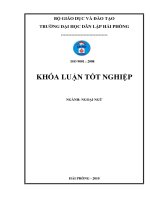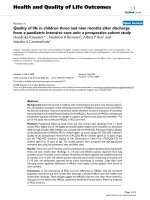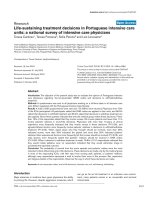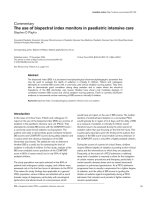Withdrawal of life-support in paediatric intensive care - a study of time intervals between discussion, decision and death
Bạn đang xem bản rút gọn của tài liệu. Xem và tải ngay bản đầy đủ của tài liệu tại đây (309.06 KB, 6 trang )
Oberender and Tibballs BMC Pediatrics 2011, 11:39
/>
RESEARCH ARTICLE
Open Access
Withdrawal of life-support in paediatric intensive
care - a study of time intervals between
discussion, decision and death
Felix Oberender1* and James Tibballs1,2
Abstract
Background: Scant information exists about the time-course of events during withdrawal of life-sustaining
treatment. We investigated the time required for end-of-life decisions, subsequent withdrawal of life-sustaining
treatment and the time to death.
Methods: Prospective, observational study in the ICU of a tertiary paediatric hospital.
Results: Data on 38 cases of withdrawal of life-sustaining treatment were recorded over a 12-month period (75%
of PICU deaths). The time from the first discussion between medical staff and parents of the subject of withdrawal
of life-sustaining treatment to parents and medical staff making the decision varied widely from immediate to 457
hours (19 days) with a median time of 67.8 hours (2.8 days). Large variations were subsequently also observed from
the time of decision to actual commencement of the process ranging from 30 minutes to 47.3 hrs (2 days) with a
median requirement of 4.7 hours. Death was apparent to staff at a median time of 10 minutes following
withdrawal of life support varying from immediate to a maximum of 6.4 hours. Twenty-one per cent of children
died more than 1 hour after withdrawal of treatment. Medical confirmation of death occurred at 0 to 35 minutes
thereafter with the physician having left the bedside during withdrawal in 18 cases (48%) to attend other patients
or to allow privacy for the family.
Conclusions: Wide case-by-case variation in timeframes occurs at every step of the process of withdrawal of lifesustaining treatment until death. This knowledge may facilitate medical management, clinical leadership, guidance
of parents and inform organ procurement after cardiac death.
Keywords: withdrawal and withholding of life-sustaining treatment, time, end-of-life care, terminal care, death,
organ donation after cardiac death
Background
Withdrawal of life-sustaining treatment has become the
predominant end-of-life scenario in children’s hospitals
in the developed world. A variety of studies over the last
two decades have highlighted the intensive care setting
as the central, and in some instances nearly exclusive,
place for making life and death decisions within a modern children’s hospital [1-5]. Although physician, nursing, ethical and legal aspects have since been important
foci of research in this difficult-to-study area [6,7], scant
* Correspondence:
1
Intensive Care Unit, Royal Children’s Hospital, Melbourne, Victoria, VIC 3052,
Australia
Full list of author information is available at the end of the article
information exists about the time-course of the process
of withdrawal of life-sustaining treatment from the
moment of discussion to actual death. Limited knowledge of this aspect of care contributes to the formidable
challenges of medical decision-making, bedside management, the provision of clinical leadership and guidance
for parents at critical and painful moments. In addition,
the advent and promotion of organ procurement after
cardiac death sees the specialty engaged in a controversy
about its role in the management of the dying process
[8-10] and this also warrants a deeper understanding of
the time-course of the events leading to death after
withdrawal of life-sustaining treatment.
© 2011 Oberender and Tibballs; licensee BioMed Central Ltd. This is an Open Access article distributed under the terms of the Creative
Commons Attribution License ( which permits unrestricted use, distribution, and
reproduction in any medium, provided the original work is properly cited.
Oberender and Tibballs BMC Pediatrics 2011, 11:39
/>
In this paper, we present the results of a 12-month
prospective, observational study aiming to elucidate the
time required for end-of-life decisions and subsequent
withdrawal of life-sustaining treatment in an Australian
paediatric intensive care unit.
Methods
A prospective, observational study of deaths occurring
in the Paediatric Intensive Care Unit (PICU) was conducted at the Royal Children’s Hospital (RCH) Melbourne, Australia. The RCH is a 250-bed tertiary
teaching hospital, which serves a population of approximately 6 million. The PICU is an 18-bed comprehensive
intensive care facility admitting approximately 1400 children per year. It is engaged in the full spectrum of paediatric critical care including cardiac and trauma care.
Information was obtained for deaths occurring during
a period of 12 months (2007). Data collection for each
case commenced when the decision to withdraw lifesustaining treatment had been taken by medical staff
and parents. While retrospective information about the
discussions regarding withdrawal of life-sustaining treatment had to be obtained from the medical record, all
other data from that point on was collected contemporaneously. This involved one of the two researchers
being either present at the time of withdrawal of lifesustaining treatment or collecting the data immediately
afterwards, i.e. at the beginning of the following shift in
case the researcher was not present when death
occurred. Data collected included diagnostic category,
age at the time of death, time of first discussion between
medical staff and parents about withdrawal of life-support, time of the decision made by medical staff and
parents to proceed with withdrawal, the initiation of
withdrawal followed by the times of apparent and confirmed death. The term apparent death denotes the
appearance of death to bedside personnel (physician or
nurse) before confirmation by clinical examination. In
addition, information was collected about presence of
monitoring and staff during withdrawal of life-sustaining
treatment. The data analysis excluded cases of withholding of life-sustaining treatment as varying levels and
modes of life-support may continue to be provided to
patients in this category in our unit. In contrast, withdrawal of life-support in our unit invariably entailed the
discontinuation of all life-support (ventilation, inotropic
infusions, extracorporeal life-support).
Numerical data was assumed to be non-parametric
with calculation of median values and statement of
minimum and maximum values. Data regarding the reasons for withdrawal of life-support, pharmacological
management as well as number, occupation and seniority of staff present at the bedside was also obtained but
is the subject of a separate paper. The research was
Page 2 of 6
approved by the RCH Ethics in Human Research Committee and written informed consent was not required
for this observational study.
Results
Fifty-one deaths occurred in the PICU during the 12
months of the study. Forty children (78%) died following
the decision to withdraw life-sustaining treatment while
5 (10%) died with some intensive care treatment being
withheld. Six children (12%) died during resuscitation
efforts. There was no case of confirmed brain death
considered for organ donation. Complete datasets of 38
cases of withdrawal of life-sustaining treatment were
recorded (75% of total PICU deaths, 95% of deaths following withdrawal of life-sustaining treatment). Three
cases involved the withdrawal of extracorporeal life-support (1 ECMO, 2 LVAD) in addition to withdrawal of
ventilation and inotropic infusions. Data of two cases
were incomplete/unavailable. Distribution of age and
diagnostic categories are displayed in table 1.
The timeframes for addressing the issue of a withdrawal of life-sustaining treatment varied widely (Table 2).
Similarly, significant time variations were recorded for
the dying process. The median time from withdrawal of
life-sustaining treatment to confirmation of death was
17 minutes (0.28 hrs.) ranging from immediate to a
maximum of 6 hours and 28 minutes. Death was apparent at a median time of 10 minutes following withdrawal of life support varying from immediate to a
maximum of 6.4 hours. The dying process took more
than 1 hour in 8 of the 38 children (21%) (Figure 1).
Medical confirmation of death took place from 0
Table 1 Distribution of age and diagnostic categories
amongst children in whom life-sustaining treatment was
withdrawn
Parameter
Number
Percentage (%)
n = 38
Age
Infant (0-12 months)
15
39
Young child (>1-4 years)
10
26.5
Older child (5-10 years)
5
13
Adolescent (11-17 years)
7
18.5
Young adult (>18 years)
1
3
11
6
29
16
Diagnostic Category
Cardiac
Haematology/Oncology
Neurology
5
13
Hypoxic-ischaemic brain injury
4
10.5
Infectious Diseases
4
10.5
Respiratory
3
8
Gastrointestinal and metabolic
3
8
Trauma
2
5
Oberender and Tibballs BMC Pediatrics 2011, 11:39
/>
Page 3 of 6
Table 2 Timeframes of the decision-making process about withdrawal of life-sustaining treatment (hours)
Timeframe
Minimum
Median
Maximum
A - from first discussion between medical staff and parents to decision
0
7.75
457 (19d 1 hr)
B - from decision to withdrawal
0.5
4.71
47.33 (1d 23 hrs 20 min)
AB - from first discussion between medical staff and parents to withdrawal
0.75 (45 min)
27.21 (1d 3 hrs 13 min)
479.08 (19d 23 hrs 5 min)
minutes (minimum and median) to 35 minutes (maximum) thereafter with physicians having left the bedside
during withdrawal in 18 cases (47%) to attend other
patients or to give the family private time. The physician
was present throughout the withdrawal process in 20
cases (53%).
In the vast majority of cases (35; 92%) all monitoring
had been discontinued for withdrawal of life-sustaining
treatment. Full monitoring (pulse oximetry, blood pressure, ECG, respiratory rate) had been continued in 2
cases and one case was managed with ongoing pulse
oximetry only.
Discussion
The proportion of cases of withdrawal of life-sustaining
treatment among all unit deaths in our study is, at 78%,
considerably larger than the percentages reported from
other institutions. Studies from North America and the
United Kingdom have described the percentage of withdrawal of treatment among the overall unit death rate
between 60% and 65% [11,12] while authors from Europe and Brazil determined that proportion to lie below
50% [13,14]. The reasons for these differences may be
diverse and include varying clinical practices, different
attitudes, cultural backgrounds and, not least, changes
in practice developing over time. Patient populations,
too, may differ as some units, particularly in Europe,
also practice neonatal intensive care [13]. Overall, however, the data of our study conform with the findings of
other published research, in that the majority of deaths
in the paediatric intensive care unit follows a decision to
withdraw or withhold life-sustaining treatment rather
than failed resuscitation efforts [15]. With regards to
distribution of age and diagnostic categories, our data
broadly reflect the patient population in an Australian
PICU [16].
The nature of withdrawal of life-sustaining treatment
prevents its study in randomised, controlled trials. Being
observational and, as a study in a field with low mortality, inevitably being limited in the number of cases, our
data must not be overinterpreted. The data is descriptive
and merely depicts current clinical practice. Timeframes
therefore should not be interpreted as benchmarks but
instead observed as variables warranting examination
and subject to a multitude of confounders, which are
beyond control in this setting. The design of our study
therefore strongly cautions against aiming to find correlations between the data. Its purpose was rather to
time (hrs)
¡
6:00
5:00
4:00
3:00
2:00
1:00
0:00
Figure 1 Time from withdrawal of life-sustaining treatment to apparent death.
cases 1 to 38
…………
quartiles
-------
1 hour
Oberender and Tibballs BMC Pediatrics 2011, 11:39
/>
facilitate understanding of a complex area of clinical
practice by assembling a comprehensive picture of what
until now has existed as fragmented pieces of data,
records and subjective experience.
Nonetheless, having been conducted in a predominantly prospective, contemporaneous fashion, the study
accurately describes current time-courses and clinical
practice in a large, tertiary PICU. The data show
extreme case-by-case variations in time at every step of
the withdrawal process until death. Time-related information regarding the decision-making process is currently not available in the literature. Garros and
colleagues, in a prospective survey, reported slightly less
than half of end-of-life discussions requiring two or
more meetings between the family and medical staff
[12]. Our data describe the overall times from the first
discussion between medical staff and parents about the
subject to implementing the decision as a heavily
skewed distribution. Most decisions are made and carried out within a day, yet only slightly less than half
take longer and at times are drawn out considerably.
Implementation of withdrawal of life-sustaining treatment appears not to be significantly postponed after the
decision. In most cases this is done within less than 5
hours, however, a maximum delay of 2 days was also
recorded. Taken as a whole, the intervals captured show
the time-intensive and greatly variable nature of end-oflife discussions and decision-making in the PICU. In the
context of our unit, decision-making is a shared process
between medical staff and parents. It is, however, important to note that our study was not designed to record
the time it may have taken within the PICU team to
reach consensus before entering into dialogue with the
parents.
With regards to the dying process, other reports had
previously described approximate timeframes for the
end of life based on retrospective studies. McCallum
and colleagues recorded a timeframe from making a
Do-Not-Resuscitate order to death of less than 24 hours
[17] while Garros and colleagues determined a median
time from decision to death of 3 hours [12]. In a more
detailed audit, Zawistowski and colleagues described a
timeframe of 30 minutes to 4.5 hours from withdrawal
to death [18]. While being very informative in general,
the confidence in the data obtained from these studies
is limited by their retrospective nature, consequently
having had to rely on the accuracy of patient records
and narrative medical notes. We have endeavoured to
capture the end of life contemporaneously and thus
included not only the time of certification of death but
also the time when death seemed apparent at the bedside in the absence of monitoring. Discontinuation of
monitoring immediately before withdrawal of life-sustaining treatment is common practice in our unit in
Page 4 of 6
order to give parents time with their child with the least
possible interference from medical technology. Confirmation of death, nevertheless, was not significantly
delayed with most deaths having been certified immediately. A variety of reasons, however, may lead the physician to postpone this such as the wish to give the
grieving family undisturbed time with the body of the
child but also other urgent issues in the unit that need
attending.
This notwithstanding, our prospective data confirm
Zawistowski’s finding that most children die within the
first hour after withdrawal of life-sustaining treatment.
Our data do, however, also show that this broad conclusion needs to be further qualified as some children die
instantly following the withdrawal of treatment while,
importantly, there also exists a great variation in the
time to death. With a median time of 0.28 hours from
withdrawal of treatment to confirmed death, the dying
process occurred within less than 20 minutes in most
children but took longer in just under half the cases.
Most importantly, our data again provide evidence of
considerable variations in timeframes from withdrawal
of life-sustaining treatment to death. The relatively
small number of cases and the variety of confounders in
a non-controlled study setting prohibit correlating diagnosis or level of intensive care support with a timecourse following withdrawal. Clinical acumen and intuition, on the other hand, have in the past been proven
inaccurate in similar circumstances for more homogenous patient populations [19]. It is reasonable to assume
that they, too, may not be reliable in predicting time to
death.
For the doctor and nurse at the bedside, knowledge of
this fact will be essential for planning the withdrawal
process and the care for the child at the end of life.
This will not only pertain to logistics and a pharmacological management plan but also to defining roles, duties
and boundaries during what will be a process of
unknown duration. Preparing the family for the dying
process that is unpredictable in time may then help to
guide parents and relatives during agonizing moments
for which few will have points of reference. This may
indeed offer an opportunity to prevent increasing
anguish if the end of life is drawn out and give the
family a better chance to cherish the last moments with
their dying child.
Another layer of complexity is added to the end of life
if organ donation after cardiac death (DCD) is considered. Current guidelines in Australia and New Zealand
acknowledge the fact that time to death is unpredictable
yet fail to address the practicalities of this circumstance
[20]. In the context of DCD, the time to death assumes
additional logistical importance to medical staff caring
for the dying patient and may have added emotional
Oberender and Tibballs BMC Pediatrics 2011, 11:39
/>
significance to the grieving parents who have made the
decision to donate the organs of their child if death
occurs within a set timeframe. Limited, retrospective
information about children considered for DCD in
North America had to date yielded data of considerable
disparity with regards to the time to death after withdrawal of life-sustaining treatment. Naim and colleagues, in
a small series of 12 DCD candidates, found no child to
have lived longer than 35 minutes after extubation [21].
Durall et. al. counted 14 out of 24 (58%) possible DCD
candidates as having survived for more than one hour
after withdrawal of life-support [22] while Pleacher and
colleagues reported 2 out of 7 (29%) children who did
not undergo planned DCD because of the dying process
lasting more than 60 minutes [23]. Our prospectively
collected data may offer encouraging information for
proponents of DCD as the majority of deaths in the paediatric ICU did indeed occur within a narrow time span
and 79% of children died within one hour, commonly
given as the time limit within which organ procurement
may occur. On the other hand, however, the unpredictability and great variation in times to death may make
DCD impracticable in a large minority of cases (21% in
our study). If organ procurement after withdrawal of
life-sustaining treatment is contemplated, it is consequently essential that this unpredictability and variation
in time to death is considered and addressed both when
planning the process and in discussions with parents.
Conclusions
There is a wide case-by-case variation in timeframes at
every step of the process of withdrawal of life-sustaining
treatment. Understanding the time-course of events in
this important area of paediatric intensive care is essential for providing high-quality medical management,
clinical leadership and guidance to parents at a most
challenging time. The unpredictability and considerable
variation in time to death may constitute a noteworthy
challenge for accomplishing organ procurement after
cardiac death.
Abbreviations
DCD: Donation after Cardiac Death; ECMO: Extracorporeal Membrane
Oxygenation; LVAD: Left Ventricular Assist Device; PICU: Paediatric Intensive
Care Unit; RCH: The Royal Children’s Hospital.
Author details
1
Intensive Care Unit, Royal Children’s Hospital, Melbourne, Victoria, VIC 3052,
Australia. 2Departments of Paediatrics & Pharmacology, University of
Melbourne Royal Children’s Hospital, Melbourne, Victoria, VIC 3052, Australia.
Authors’ contributions
JT and FO jointly designed and conducted the study which had been
conceived by JT. FO created the database, analysed as well as interpreted
the data and drafted the article. JT and FO jointly revised the article. Both
authors provided intellectual content of critical importance to this project
and gave their final approval of this version to be published.
Page 5 of 6
Competing interests
JT declares that he has no competing interests. FO is affiliated with
DonateLife Victoria.
Received: 13 January 2011 Accepted: 21 May 2011
Published: 21 May 2011
References
1. Carter BS, Howenstein M, Gilmer MJ, Throop P, France D, Whitlock JA:
Circumstances surrounding the deaths of hospitalized children:
opportunities for pediatric palliative care. Pediatrics 2004, 114:e361-e366.
2. Moore P, Kerridge I, Gillis J, Jacobe S, Isaacs D: Withdrawal and limitation
of life-sustaining treatments in a paediatric intensive care unit and
review of the literature. J Paediatr Child Health 2008, 44:404-408.
3. Ramnarayan P, Craig F, Petros A, Pierce C: Characteristics of deaths
occurring in hospitalised children: changing trends. J Med Ethics 2007,
33:255-260.
4. Singh J, Lantos J, Meadow W: End-of-life after birth: death and dying in a
neonatal intensive care unit. Pediatrics 2004, 114:1620-1626.
5. Stark Z, Hynson J, Forrester M: Discussing withholding and withdrawing
of life-sustaining medical treatment in paediatric inpatients: audit of
current practice. J Paediatr Child Health 2008, 44:399-403.
6. Latour JM, Fulbrook P, Albarran JW: EfCCNa survey: European intensive
care nurses’ attitudes and beliefs towards end-of-life care. Nurs Crit Care
2009, 14:110-121.
7. Tibballs J: Legal basis for ethical withholding and withdrawing lifesustaining medical treatment from infants and children. J Paediatr Child
Health 2007, 43:230-236.
8. Murphy P, Manara A, Bell D, Smith M: Controlled non-heart beating organ
donation: neither the whole solution nor a step too far. Anaesthesia 2008,
63:526-530.
9. Richards B, Rogers WA: Organ donation after cardiac death: legal and
ethical justifications for antemortem interventions. Med J Aust 2007,
187:168-170.
10. Tibballs J: Organ donation after cardiac death: legal and ethical
justifications for antemortem interventions. Med J Aust 2008,
188:186-187.
11. Balfour-Lynn IM, Tasker RC: At the coalface–medical ethics in practice.
Futility and death in paediatric medical intensive care. J Med Ethics 1996,
22:279-281.
12. Garros D, Rosychuk RJ, Cox PN: Circumstances surrounding end of life in
a pediatric intensive care unit. Pediatrics 2003, 112:e371.
13. Devictor DJ, Nguyen DT: Forgoing life-sustaining treatments in children: a
comparison between Northern and Southern European pediatric
intensive care units. Pediatr Crit Care Med 2004, 5:211-215.
14. Lago PM, Piva J, Garcia PC, Troster E, Bousso A, Sarno MO, Torreao L,
Sapolnik R: End-of-life practices in seven Brazilian pediatric intensive care
units. Pediatr Crit Care Med 2008, 9:26-31.
15. Burns JP, Mitchell C, Outwater KM, Geller M, Griffith JL, Todres ID, Truog RD:
End-of-life care in the pediatric intensive care unit after the forgoing of
life-sustaining treatment. Crit Care Med 2000, 28:3060-3066.
16. ANZICS Centre for Outcome and Resource Evaluation. Report of the
Australian and New Zealand Paediatric Intensive Care Registry 2009 Australian
& New Zealand Intensive Care Society; 2010.
17. McCallum DE, Byrne P, Bruera E: How children die in hospital. J Pain
Symptom Manage 2000, 20:417-423.
18. Zawistowski CA, DeVita MA: A descriptive study of children dying in the
pediatric intensive care unit after withdrawal of life-sustaining
treatment. Pediatr Crit Care Med 2004, 5:216-223.
19. Meadow W, Lagatta J, Andrews B, Caldarelli L, Keiser A, Laporte J, PleshaTroyke S, Subramanian M, Wong S, Hron J, Golchin N, Schreiber M: Just, in
time: ethical implications of serial predictions of death and morbidity
for ventilated premature infants. Pediatrics 2008, 121:732-740.
20. Australian and New Zealand Intensive Care Society. The ANZICS
Statement on Death and Organ Donation. 3 edition. Melbourne: ANZICS;
2008.
21. Naim MY, Hoehn KS, Hasz RD, White LS, Helfaer MA, Nelson RM: The
Children’s Hospital of Philadelphia’s experience with donation after
cardiac death. Crit Care Med 2008, 36:1729-1733.
22. Durall AL, Laussen PC, Randolph AG: Potential for donation after cardiac
death in a children’s hospital. Pediatrics 2007, 119:e219-e224.
Oberender and Tibballs BMC Pediatrics 2011, 11:39
/>
Page 6 of 6
23. Pleacher KM, Roach ES, Van der WW, Antommaria AH, Bratton SL: Impact of
a pediatric donation after cardiac death program. Pediatr Crit Care Med
2009, 10:166-170.
Pre-publication history
The pre-publication history for this paper can be accessed here:
/>doi:10.1186/1471-2431-11-39
Cite this article as: Oberender and Tibballs: Withdrawal of life-support in
paediatric intensive care - a study of time intervals between discussion,
decision and death. BMC Pediatrics 2011 11:39.
Submit your next manuscript to BioMed Central
and take full advantage of:
• Convenient online submission
• Thorough peer review
• No space constraints or color figure charges
• Immediate publication on acceptance
• Inclusion in PubMed, CAS, Scopus and Google Scholar
• Research which is freely available for redistribution
Submit your manuscript at
www.biomedcentral.com/submit









